Welcome, folks! Walk into the intriguing world of the wood carving traditions of Nagaland, where each chisel extends a tale. This art is colored by ancestral belief and tribal identity and is, therefore, much more than mere decoration – it is history in carved wood. For centuries, the people of the Naga tribes have employed wood as a medium for power, status, and spirituality, creating fierce warrior totems and sculpting amazingly detailed house panels.
In modern homes, this traditional craft has smoothly evolved to be statement décor items—carved headboards, wall art, and furniture with soul. Yet, the essence remains unchanged: bold shapes, powerful symbolism, and close alliance with nature and heritage.
Whether it is an art lover, one who enjoys culture, or a person who likes handmade creations, Nagaland’s carving traditions are a fabulous entwining of the past and present. So, prepare for the opening of the door to a world where ancient stories reside – not in books, but in cut pieces of wood!
What is Nagaland’s wood carving tradition?
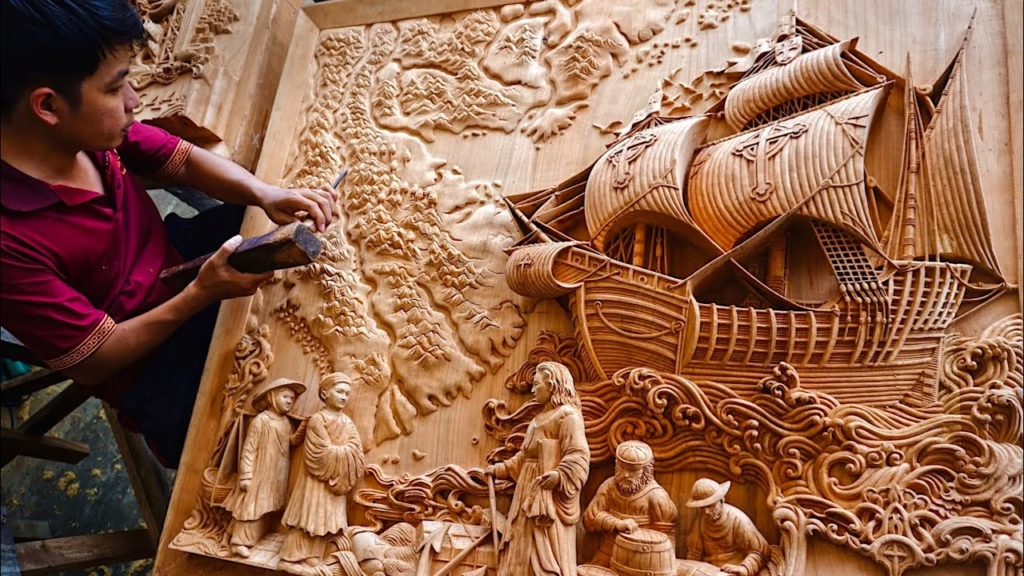
The Nagaland wood carving is one of the most outstanding and meaningful works of art in Northeast India. This art is a part of the Naga tribe’s life and goes beyond the decoration —it is a vivid storytelling, an identity mark, and a sense of ancestral pride.
That tradition was passed down from one generation to another, which involves carving bold, symbolic designs on wood, which is commonly found in village gates, houses, morungs (youth dormitories), and ceremonial pillars. Such carvings narrate tales of heroism, class, and myths of tribes.
Some common features of Naga wood carving include
- Mithun heads—symbols of wealth and strength
- Human figures—representing ancestors, warriors, or hunters
- Spears, animals, and geometric patterns—linked to folklore and tribal pride
Carvings are done mostly by hand using traditional tools, with wood sourced from local forests. Each tribe has its own unique style, reflecting its cultural roots and environment.
Today, while some traditional uses have faded, this age-old wood carving tradition lives on in modern ways—from furniture and wall art to home décor pieces. It continues to celebrate Naga heritage while adapting beautifully to contemporary aesthetics, making it a living art that bridges the past and present.
Origins of Nagaland’s Wood Carving Traditions
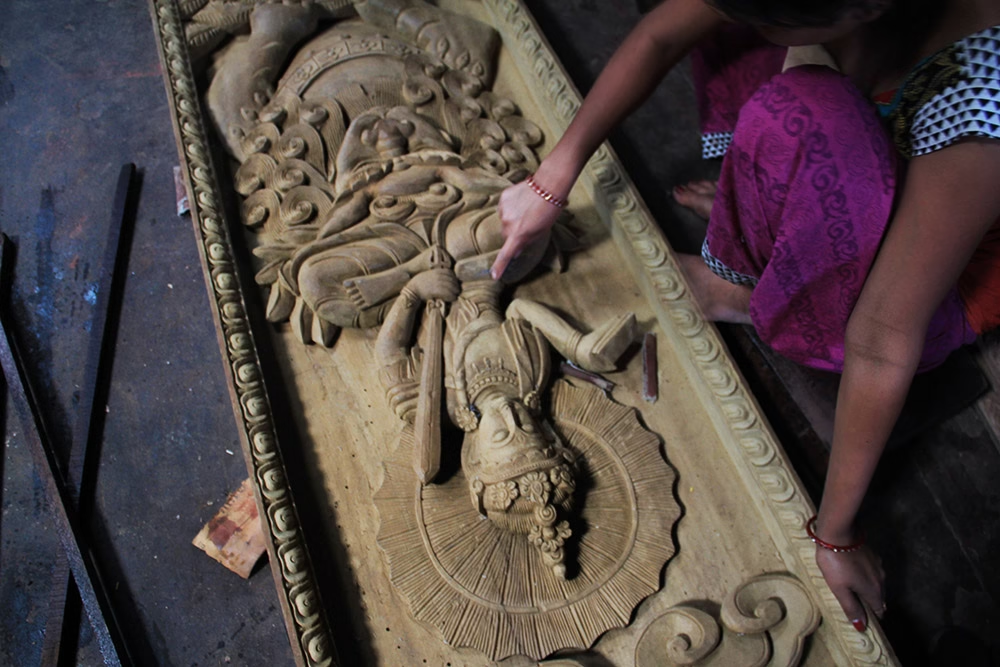
Nagaland’s wood carving tradition is one of the oldest and most culturally rich crafts in Northeast India. It is not just an art form—it’s a reflection of tribal life, warrior pride, and ancestral beliefs that have been passed down through generations.
Rooted in Tribal Heritage
The tradition dates back centuries among the Naga tribes, each giving rise to a new styling and symbolism. Wood was not a material alone. it was a spiritual aspect of daily and spiritual life. Where homes, morungs (youth dormitories), gates of the village, and memorial stones were adorned using carving.
- The Angami, Ao, and Konyak tribes are especially known for their distinct wood carving styles.
- Most early carvings featured animals, human figures, and geometric patterns—each carrying deep meaning.
- The mithun (a local bison), spears, skull motifs, and hunting scenes were common symbols representing strength, bravery, and status.
Who Started It?
There isn’t a single known individual who started this tradition. Instead, it grew organically within the tribal communities, guided by elders and clan leaders. However, the Konyak tribe is often credited for preserving some of the most detailed and dramatic forms of wood carving, especially seen in their ceremonial totem poles and headhunter houses.
- The tradition is believed to date back to the pre-16th century, well before the arrival of colonial influence.
- It began as a way to mark achievements in war, social status, and clan identity.
- Only respected craftsmen or warriors with high standing were allowed to carve certain sacred designs.
The Story Behind the Craft
Wood carving wasn’t done just for beauty—it told stories. A carved panel could show the tale of a successful hunt, a warrior’s journey, or a family’s legacy. These carvings served as historical records in a time when oral storytelling was the only form of preserving memory.
In essence, the wood carving tradition of Nagaland began not in workshops, but in forests, villages, and ceremonies—deeply tied to the rhythm of tribal life.
Certainly! Here’s the rewritten version of your section with expanded and more descriptive headings, while keeping the tone simple, engaging, and informative for an art-enthusiast audience. The focus remains on wood carving tradition, materials, methods, time, and market data.
Understanding the Materials Behind Nagaland’s Wood Carving Tradition
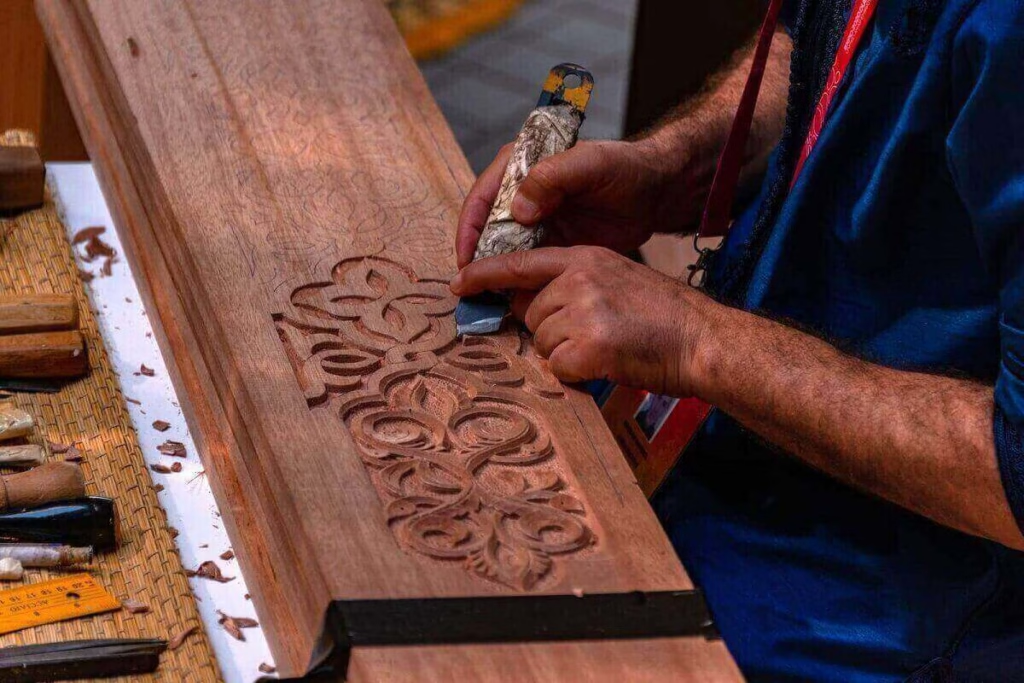
At the heart of Nagaland’s wood carving tradition lies a deep respect for nature and its resources. Local artisans carefully select specific types of wood known for their durability, texture, and carving ease. Each type serves a purpose based on the kind of artwork being made—be it a household décor item, ceremonial object, or architectural panel.
Most commonly used woods include
- Alder (Alnus nepalensis): Lightweight and easy to carve, this is the go-to wood for most traditional pieces. Found abundantly in the hilly regions of Nagaland.
- Teak: Preferred for larger or more durable works, especially furniture or doors. Known for strength and resistance to insects.
- Walnut wood: Used for high-end carvings due to its beautiful grain and rich color.
- Bamboo: Though not wood, bamboo is often used in combination with wood for small design accents.
These materials are locally sourced, often harvested in ways that support sustainability and community forestry.
Step-by-Step: Traditional Techniques and Time-Honored Carving Methods
Nagaland’s wood carving process follows traditional methods that have been passed down through generations. These techniques rely on simple, hand-held tools and a great deal of skill and patience.
The typical process involves
- Selection and seasoning of wood—The wood is chosen based on the type of item to be made and dried naturally for 1–2 weeks to reduce moisture and prevent warping.
- Freehand sketching on the surface—Artisans draw outlines directly onto the wood without stencils, guided by years of experience.
- Rough shaping—Using tools like the adze, the basic form is carved out.
- Detailed work—Chisels and knives are used to add intricate patterns, motifs, and figures.
- Finishing and polishing—The final product is polished, sometimes painted or coated, depending on tradition or buyer preference.
This method emphasizes craftsmanship over machinery, making every piece unique.
How Long Does It Take? Understanding the Time and Effort Behind Each Piece
Wood carving in Nagaland isn’t a quick process—it’s a slow and respectful journey from raw wood to finished art.
- Small items (e.g., wall plaques, ornaments): 2–5 days
- Medium panels or totem carvings: 2–4 weeks
- Large structures or ceremonial pieces: 1–3 months or more
Each piece’s time depends on complexity, size, and the artisan’s experience. Traditional carvers often work in teams for large commissions, especially for community or temple structures.
Breaking Down the Investment: Cost of Materials, Tools, and Labor
Creating a piece of Naga wood carving involves thoughtful investment—not just in materials, but in time and tradition.
- Wood cost: ₹1,000–₹5,000 depending on the type and size
- Tool set (traditional hand tools): ₹2,000–₹4,000 for a basic set
- Labor cost: Based on carving complexity and hours of work
- Average total investment for a mid-sized panel: ₹4,000–₹10,000
Despite these modest costs, the craftsmanship involved can command much higher prices in both local and international markets, especially when buyers appreciate the handmade value.
From Village Workshop to Global Market: Wood Carving’s Economic Impact
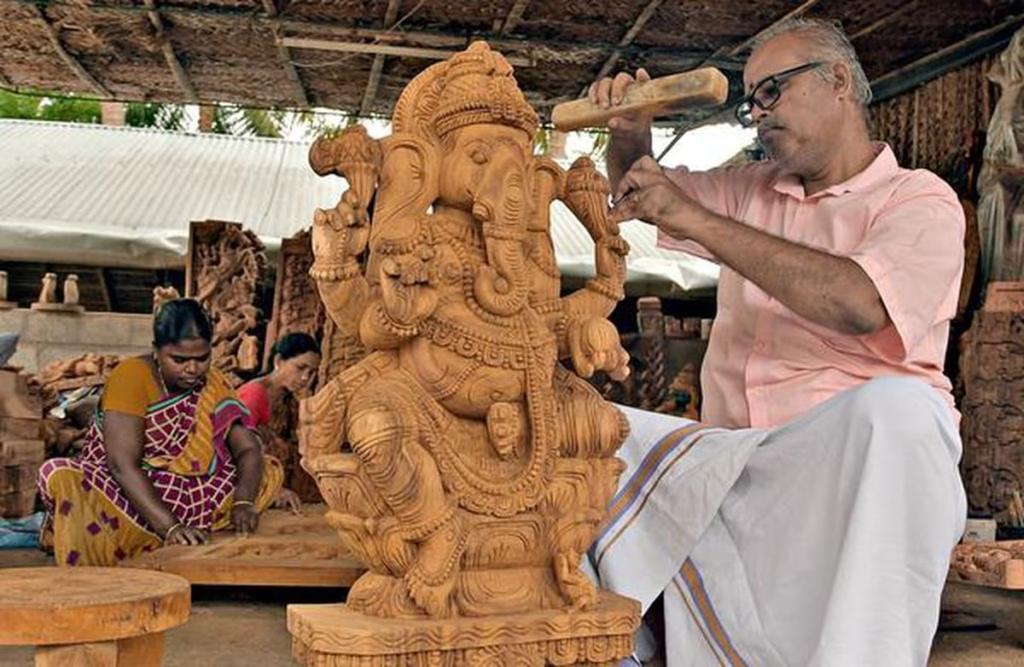
Nagaland’s wood carving tradition is gaining global recognition, helping artisans turn heritage into a livelihood.
- In 2023, India’s handicraft exports reached $3.5 billion, with wood crafts making up about 18% of that.
- Online platforms and artisan collectives have led to a 20% rise in visibility for Northeast Indian crafts, including Naga woodwork.
- A mid-sized hand-carved piece sells for ₹6,000–₹15,000 locally and can reach $200 to $1,500 internationally, especially in curated decor stores or exhibitions.
As demand grows for sustainable and handcrafted products, Naga wood carving stands out for its authenticity and aesthetic richness. Art collectors and home décor lovers worldwide are now looking beyond factory-made items to appreciate this deep-rooted art form.
Absolutely! Here’s an expanded and engaging version of the section “Symbolism in Naga Wood Carvings,” with each motif and symbol described in more detail. This version maintains a crisp, friendly tone while offering deeper cultural insight for art-enthusiast readers.
Symbolism in Naga Wood Carvings: Stories Etched in Timber
In Nagaland, every carved object is more than visual appeal—it’s a living story. The symbols carved into wood by Naga artisans hold spiritual, social, and ancestral significance. Whether found on house posts, ceremonial gates, or furniture, these motifs communicate power, protection, memory, and identity. Let’s explore these iconic symbols in detail, one by one.
1. Mithun Head: The Emblem of Wealth and Prestige
The mithun, a majestic bovine native to the Northeast, holds deep cultural value among the Nagas.
- Symbolism: Prosperity, social status, and merit.
- Where it’s used: Prominently carved on entrance panels, house beams, or totem-like posts.
- Cultural Meaning: Only individuals or families who have hosted Feasts of Merit—grand community feasts given by wealthy or generous individuals—earn the right to display the mithun motif.
- Visual Features: The carved head is often bold and symmetrical, with wide horns and deep eyes to symbolize nobility and strength.
2. Spears and Daos (Traditional Naga Blades): Icons of Courage and Warrior Pride
Weapons are among the most recognizable motifs in traditional wood carvings.
- Spears: Represent valor, hunting skill, and defense. Spears were vital tools in tribal warfare and ritual hunts.
- Daos: The Naga dao, a broad, curved blade, is both a tool and weapon, symbolizing strength, survival, and masculine identity.
- Where it’s used: Carved across door frames, clan gates, and ceremonial poles.
- Visual Detail: Crossed spears or upward-facing daos often indicate an active warrior lineage.
3. Human Figures: Memory, Spirit, and Guardianship
Human forms are central to wood carvings in Nagaland, each carved with a clear purpose.
- Ancestor Figures: Often tall and stylized, placed on central support posts of homes or in sacred spaces. Believed to protect the household and connect the living with the spirits of elders.
- Warrior Figures: Shown standing confidently, sometimes holding weapons or enemy heads (symbolic, not literal), representing bravery and honor earned in battle.
- Spirit Figures: Sometimes stylized with exaggerated features, these are guardians or deities carved to watch over a village or forest boundary.
Each human form carved is more than decorative—it’s a presence, a protector, a memory made visible.
4. Animal Motifs Beyond the Mithun: Connection to Nature
Other animals occasionally appear in carvings and carry unique meanings:
- Tigers or leopards: Represent stealth, strength, and dominance—sometimes linked with tribal myths or clan guardians.
- Birds (especially hornbills): Seen as messengers between realms, often carved during festivals or for ceremonial use.
5. Geometric Motifs: Visual Codes of Nature and Belief
Beyond figurative imagery, abstract patterns are used to add layers of symbolism.
- Chevron or Zigzag Lines: Symbolize water, movement, or life force flowing through the home or structure.
- Spirals: Represent life cycles, rebirth, or infinity—especially seen in ceremonial or spiritual carvings.
- Triangles and Diamond Patterns: May refer to mountains, fertility, or clan-specific signs.
These motifs are often passed down within families and vary between tribes, forming a visual language unique to each community.
6. House Posts and Morungs: Large-Scale Symbolic Architecture
- Morungs (men’s dormitories): Traditionally carved with an impressive mix of warrior symbols, horns, and clan emblems to instill pride in young members.
- House posts: Feature a combination of symbols—from ancestors to animals—turning the home itself into a living narrative.
Conclusion: Naga Wood Carvings—More Than Just Pretty Patterns!
So, the next time you lay eyes on a stunning Naga wood carving, remember: it’s not just a piece of décor—it’s a conversation starter! From mithun heads to warrior spears, every curve and chisel tells a story of bravery, tradition, and a little bit of ancient Naga swagger.
Whether it’s protecting the home or honoring an ancestor, these carvings are as symbolic as they are stunning. They’re more than artwork—they’re living history with a whole lot of style!
So, let’s give a round of applause (and maybe a few more sales!) to the talented artisans who keep this vibrant tradition alive. After all, where else can you find heritage and home décor in one beautifully carved package? Talk about multitasking art!
If you have enjoyed reading this article, dig in to learn more about India’s famous art and architecture in every corner from folkcanvas.

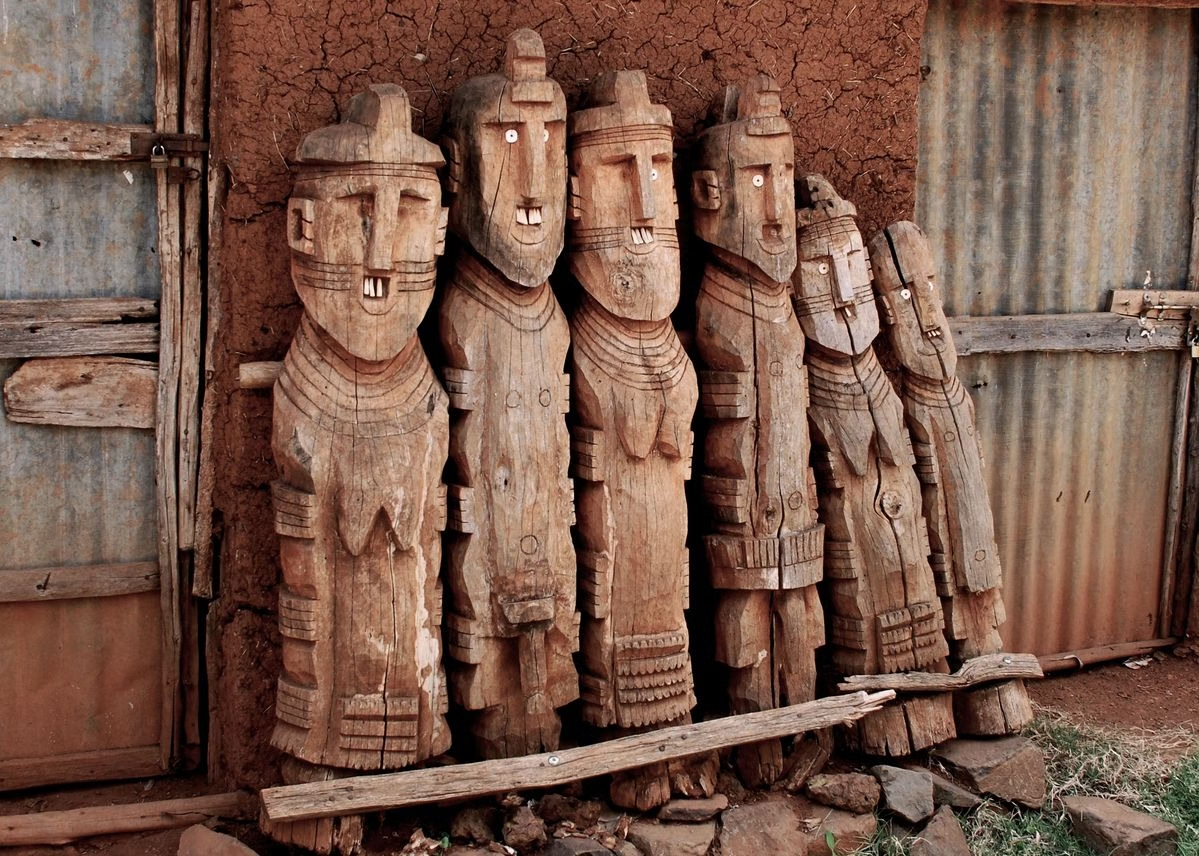
Leave a Reply